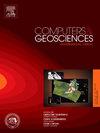A reversible-jump Markov chain Monte Carlo algorithm to estimate paleo surface CO2 fluxes linking temperature to atmospheric CO2 concentration time series
IF 4.4
2区 地球科学
Q1 COMPUTER SCIENCE, INTERDISCIPLINARY APPLICATIONS
引用次数: 0
Abstract
Future goals and strategies for mitigating ongoing climate changes rely on the understanding of the global carbon cycle and its connections to climate. Evidence from ice cores regarding past atmospheric CO2 and temperature changes through glacial-interglacial oscillations provide crucial insight into the natural variability of carbon cycling. However, poor constraints on atmospheric CO2 input and output fluxes limit our quantitative understanding of late Pleistocene carbon cycling and climate changes. In this study, we describe an inversion method based on a reversible-jump Markov chain Monte Carlo (rj-McMC) algorithm and a general formulation of the geological carbon cycle to estimate paleo-fluxes of CO2. We present results from two synthetic tests and a real case study based on data from the ice core of Dome Fuji. Results from synthetic tests demonstrate the capability of the algorithm to retrieve reliable estimates of atmospheric CO2 input and output fluxes inverting the time derivative of the atmospheric CO2 record and using its temperature time series as a further constraint. Results from the Dome Fuji case study underscore systematic pulses of input CO2 fluxes into the atmosphere during deglaciations predating peaks of T and output CO2 fluxes by ∼2.5 kyrs. The retrieved surface source and sink CO2 fluxes as well as future applications of the algorithm presented here will provide new insights to assess past climate driving mechanisms and inform projections of future climatic trajectories.
用可逆跳变马尔可夫链蒙特卡罗算法估计古地表CO2通量,将温度与大气CO2浓度时间序列联系起来
减缓持续气候变化的未来目标和战略取决于对全球碳循环及其与气候的联系的理解。来自冰芯的证据表明,通过冰期-间冰期振荡,过去的大气CO2和温度变化为碳循环的自然变动性提供了重要的见解。然而,对大气CO2输入和输出通量的限制较差,限制了我们对晚更新世碳循环和气候变化的定量认识。本文提出了一种基于可逆跳跃马尔可夫链蒙特卡罗(rj-McMC)算法和地质碳循环一般公式的古CO2通量反演方法。我们介绍了两个合成测试的结果和一个基于圆顶富士冰芯数据的实际案例研究。综合试验结果表明,该算法能够反演大气CO2记录的时间导数,并将其温度时间序列作为进一步的约束条件,检索大气CO2输入和输出通量的可靠估计。来自Dome Fuji案例研究的结果强调了在冰川消融期间进入大气的输入CO2通量的系统脉冲,这些脉冲早于T峰值和输出CO2通量约2.5 kys。检索到的地表源和汇CO2通量以及本文提出的算法的未来应用将为评估过去的气候驱动机制和预测未来气候轨迹提供新的见解。
本文章由计算机程序翻译,如有差异,请以英文原文为准。
求助全文
约1分钟内获得全文
求助全文
来源期刊

Computers & Geosciences
地学-地球科学综合
CiteScore
9.30
自引率
6.80%
发文量
164
审稿时长
3.4 months
期刊介绍:
Computers & Geosciences publishes high impact, original research at the interface between Computer Sciences and Geosciences. Publications should apply modern computer science paradigms, whether computational or informatics-based, to address problems in the geosciences.
 求助内容:
求助内容: 应助结果提醒方式:
应助结果提醒方式:


